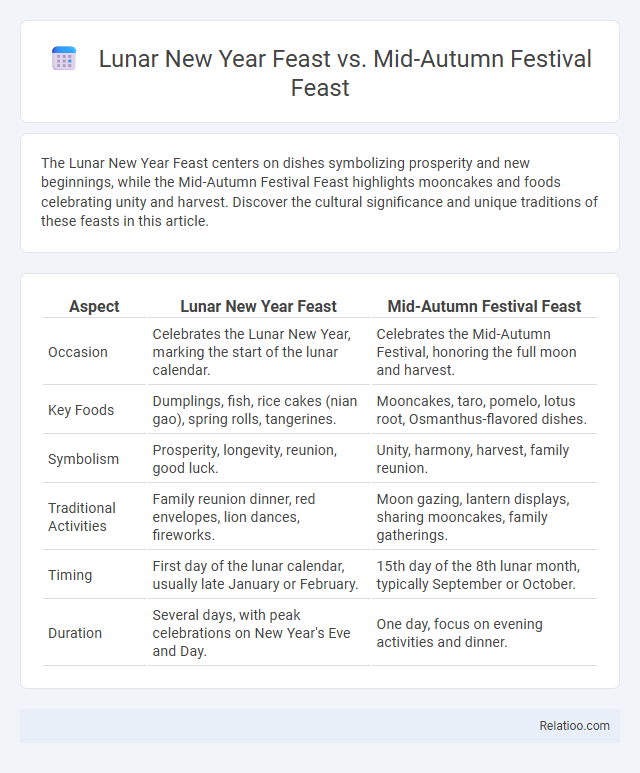The Lunar New Year Feast centers on dishes symbolizing prosperity and new beginnings, while the Mid-Autumn Festival Feast highlights mooncakes and foods celebrating unity and harvest. Discover the cultural significance and unique traditions of these feasts in this article.
Table of Comparison
| Aspect | Lunar New Year Feast | Mid-Autumn Festival Feast |
|---|---|---|
| Occasion | Celebrates the Lunar New Year, marking the start of the lunar calendar. | Celebrates the Mid-Autumn Festival, honoring the full moon and harvest. |
| Key Foods | Dumplings, fish, rice cakes (nian gao), spring rolls, tangerines. | Mooncakes, taro, pomelo, lotus root, Osmanthus-flavored dishes. |
| Symbolism | Prosperity, longevity, reunion, good luck. | Unity, harmony, harvest, family reunion. |
| Traditional Activities | Family reunion dinner, red envelopes, lion dances, fireworks. | Moon gazing, lantern displays, sharing mooncakes, family gatherings. |
| Timing | First day of the lunar calendar, usually late January or February. | 15th day of the 8th lunar month, typically September or October. |
| Duration | Several days, with peak celebrations on New Year's Eve and Day. | One day, focus on evening activities and dinner. |
Introduction: Celebrating Lunar New Year and Mid-Autumn Festival
Lunar New Year Feast and Mid-Autumn Festival Feast both hold significant cultural importance, marked by unique traditions and symbolic dishes that celebrate family unity and prosperity. Your Lunar New Year Feast centers on foods like dumplings and fish that symbolize wealth and abundance, while the Mid-Autumn Festival Feast highlights mooncakes and pomelo, representing harmony and reunion under the full moon. Each feast enriches cultural heritage through its distinctive rituals and culinary delights, fostering meaningful celebrations across generations.
Historical Origins of Both Festive Feasts
The Lunar New Year Feast traces its origins to ancient China, symbolizing the start of a new lunar calendar and featuring dishes that invoke prosperity and good luck for the coming year. The Mid-Autumn Festival Feast celebrates the harvest moon and family reunion, with roots in moon worship and agricultural rituals dating back over 3,000 years. Your understanding of these feasts highlights how their historical origins influence the symbolic foods and celebrations central to Chinese cultural heritage.
Key Symbolic Foods of Lunar New Year
Key symbolic foods of the Lunar New Year feast include dumplings, which represent wealth and prosperity, and fish, symbolizing abundance and surplus. In contrast, the Mid-Autumn Festival feast highlights mooncakes, embodying unity and completeness. Your Lunar New Year celebration centers on foods that bring good fortune and family harmony for the coming year.
Signature Dishes of the Mid-Autumn Festival
Signature dishes of the Mid-Autumn Festival prominently feature mooncakes, which are round pastries filled with lotus seed paste, red bean paste, or salted egg yolk, symbolizing reunion and completeness. Unlike the Lunar New Year Feast that centers on dumplings, fish, and glutinous rice cakes representing prosperity and wealth, the Mid-Autumn Festival Feast highlights seasonal fruits like pomelos and taro to evoke family unity and abundant harvest. The distinct emphasis on mooncakes and seasonal produce sets the Mid-Autumn Festival Feast apart from other traditional Chinese celebrations focused on symbolic foods.
Cultural Significance of Each Festival Meal
The Lunar New Year Feast symbolizes renewal and prosperity, featuring traditional dishes like dumplings and fish that represent wealth and abundance. The Mid-Autumn Festival Feast emphasizes family reunion and gratitude, highlighting mooncakes and seasonal fruits as symbols of harmony and completeness. Your celebration experience is enriched by understanding these distinct cultural significances, reflecting deep-rooted traditions in each feast.
Rituals and Family Traditions Around the Table
Lunar New Year Feasts center around symbolic dishes like dumplings and fish, embodying prosperity and unity, with families gathering to honor ancestors and set off firecrackers. Mid-Autumn Festival Feasts highlight mooncakes and seasonal fruits, fostering reunion under the full moon while sharing stories and gratitude for the harvest. Typical family feasts emphasize communal bonding through shared meals and rituals, reflecting cultural heritage and reinforcing social ties.
Regional Variations in Festive Menus
Regional variations in festive menus highlight distinct culinary traditions between the Lunar New Year Feast, Mid-Autumn Festival Feast, and general Feast celebrations. The Lunar New Year Feast often features dishes symbolizing prosperity and luck, such as dumplings and fish, predominantly in northern and southern China. Your experience may vary with the Mid-Autumn Festival Feast emphasizing mooncakes and taro across East Asia, while broader Feast occasions incorporate diverse seasonal ingredients reflecting local cultural preferences.
Sweet vs. Savory: Comparing Festive Treats
Lunar New Year feasts emphasize sweet rice cakes like nian gao symbolizing prosperity, while Mid-Autumn Festival treats favor sweet mooncakes filled with lotus seed paste or red bean, representing reunion. In contrast, typical feasts may lean more towards savory dishes such as braised meats, dumplings, and stir-fried vegetables showcasing culinary richness. Your choice between these celebrations hinges on whether you prefer traditional sweet delicacies or savory flavors that highlight festive symbolism and family togetherness.
Modern Twists on Traditional Feasts
Modern twists on the Lunar New Year Feast include fusion dishes such as sushi rolls filled with traditional fillings like sticky rice and red bean paste, combining Asian flavors with contemporary cuisine techniques. The Mid-Autumn Festival Feast now features innovative mooncake flavors like matcha green tea, salted caramel, and durian mousse, appealing to younger generations and gourmet palettes. Overall, traditional feasts have embraced health-conscious ingredients, plant-based options, and artistic food presentations, reflecting evolving cultural tastes and global culinary trends.
Conclusion: Unity and Heritage Through Festive Food
Feasting during the Lunar New Year, Mid-Autumn Festival, and other traditional celebrations symbolizes more than just indulgence; they represent unity and the preservation of cultural heritage. Your participation in these feasts strengthens communal bonds and honors ancestral traditions through shared tastes and rituals. Each festive meal serves as a living link connecting generations and reinforcing identity within diverse communities.

Infographic: Lunar New Year Feast vs Mid-Autumn Festival Feast
 relatioo.com
relatioo.com